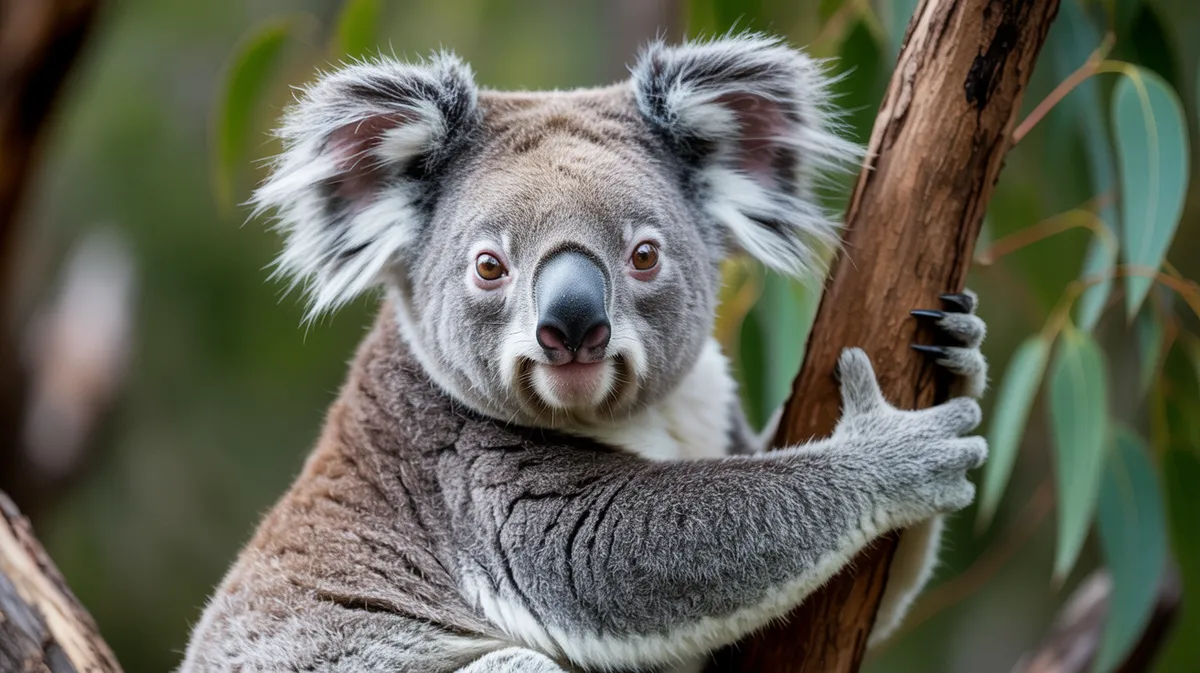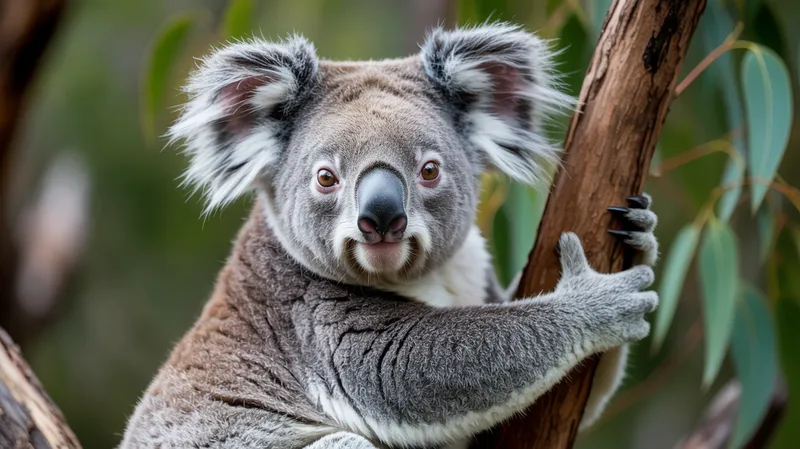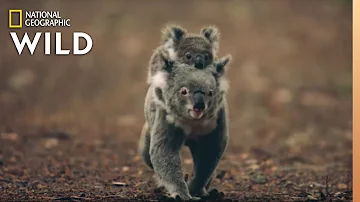
Koala
Phascolarctos cinereus

Meet the Koala
The koala is a tree-dwelling marsupial native to eastern Australia, recognized by its round, fluffy ears, large black nose, and dense, gray fur. Koalas are mostly nocturnal and spend much of their time sleeping in eucalyptus trees, which also provide their primary food source. Despite their bear-like appearance, koalas are not bears and are more closely related to wombats. They have specialized adaptations for their arboreal lifestyle, including strong limbs and sharp claws for climbing.
Classification
Mammal
Habitat
Eucalyptus forests and woodlands
Diet
Herbivore
Lifespan
10-15 years
Conservation
Vulnerable
Weight
4-15 kg
📖Fascinating Facts
Tree Dwellers
Koalas spend almost their entire lives in trees, rarely coming down except to move between trees or find new food sources.
Eucalyptus Diet
Koalas feed almost exclusively on eucalyptus leaves, consuming up to 500 grams daily from select tree species.
Marsupial Mothers
Female koalas carry their underdeveloped young, called joeys, in a pouch for about six months before the joey clings to the mother's back.
📋Detailed Description
The koala (Phascolarctos cinereus) is a medium-sized, arboreal marsupial endemic to Australia, notable for its robust, tailless body and dense, woolly fur that ranges from silver-grey in northern populations to chocolate-brown in the south. Adults typically measure 60–85 cm in length and weigh between 4–15 kg, with southern individuals generally larger and heavier than their northern counterparts. Koalas possess a large, rounded head with prominent, fluffy ears and a broad, leathery nose, adaptations that enhance their sense of smell, crucial for selecting suitable eucalyptus leaves. Their forelimbs are highly muscular and equipped with two opposable digits on each hand, aiding in grasping branches and climbing, while their hind feet have a syndactylous (fused) second and third toe for grooming. Koalas are predominantly nocturnal and crepuscular, spending up to 18–22 hours a day resting or sleeping to conserve energy due to their low-nutrient, fibrous diet. They are solitary animals, occupying overlapping home ranges with minimal social interaction except during the breeding season. Vocalizations, including bellows and grunts, are used for communication, especially by males during mating periods. The digestive system is highly specialized, featuring an elongated cecum and colon that house symbiotic bacteria to break down toxic compounds in eucalyptus leaves. Koalas have a low metabolic rate, which, combined with their sedentary lifestyle, allows them to survive on their nutrient-poor diet.
💡 Did you know?
Despite being called 'koala bears,' koalas are not bears at all—they are marsupials, carrying their young in a pouch.
🔬Research & Sources
Wikipedia Summary
The koala, sometimes inaccurately called the koala bear, is an arboreal herbivorous marsupial native to Australia. It is the only extant representative of the family Phascolarctidae. Its closest living relatives are the wombats. The koala is found in coastal areas of the island's eastern and southern regions, inhabiting Queensland, New South Wales, Victoria, and South Australia. It is easily recognisable by its stout, tailless body and large head with round, fluffy ears and large, dark nose. The koala has a body length of 60–85 cm (24–33 in) and weighs 4–15 kg (8.8–33.1 lb). Its fur colour ranges from silver grey to chocolate brown. Koalas from the northern populations are typically smaller and lighter in colour than their counterparts further south. These populations are possibly separate subspecies, but not all researchers accept this.
Last Modified: 6/11/2025
🎭Behavior & Social Structure
Koalas are primarily solitary and territorial, with each individual maintaining a home range that may overlap with others, particularly in high-quality habitats. They are most active at night (nocturnal) and during twilight hours (crepuscular), spending the majority of their waking time feeding and moving between trees. Feeding occurs mainly at night, with koalas selecting specific eucalyptus species and even individual trees based on leaf chemistry and water content. They consume 200–500 grams of leaves daily, using their sharp incisors and molars to shear and grind foliage. Koalas communicate through a range of vocalizations; males produce deep, resonant bellows that can carry over several kilometers, serving to establish dominance and attract females. Scent marking with chest glands is also used for territory delineation. Aggressive encounters are rare but may occur between males during the breeding season. Koalas descend to the ground infrequently, mainly to move between trees or access water during droughts or heatwaves.
👶Reproduction & Life Cycle
Koalas have a seasonal breeding period, typically from September to February in the southern hemisphere. Males reach sexual maturity at around 2–3 years, females at 2 years. Courtship involves vocalizations and scent marking, with dominant males securing access to receptive females. After a brief gestation of about 34–36 days, the female gives birth to a single, underdeveloped joey, which crawls unaided into the pouch. The joey remains in the pouch for approximately 6–7 months, feeding exclusively on milk. At around 6 months, the mother produces a specialized fecal matter called 'pap,' which the joey consumes to inoculate its gut with essential microbes for digesting eucalyptus. The joey gradually transitions to solid food and rides on the mother's back until weaning at 12 months. Females may breed annually, but reproductive success is influenced by environmental conditions and food availability.
🛡️Adaptations & Survival
Koalas exhibit several unique adaptations for their arboreal, folivorous lifestyle. Their opposable digits and strong limbs facilitate efficient climbing and gripping of branches. The thick, insulating fur provides protection from temperature extremes and rainfall. Their highly selective dentition, with sharp incisors and grinding molars, is adapted for processing tough eucalyptus leaves. The enlarged cecum and colon, housing specialized microflora, allow detoxification and fermentation of otherwise toxic compounds in their diet. Koalas possess a low basal metabolic rate (about 50% of that of a typical mammal of their size), enabling them to conserve energy. Behavioral adaptations include minimal movement and long periods of rest to further reduce energy expenditure. Their acute sense of smell and taste helps them detect and avoid leaves with high toxin levels.
🎨Cultural Significance
The koala is an iconic symbol of Australian wildlife and is featured prominently in national tourism, conservation campaigns, and popular culture. It holds significance in Indigenous Australian mythology, often depicted as a wise or helpful animal in Dreamtime stories. The koala's image is widely used in branding and as a mascot for environmental causes. Historically, koalas were hunted for their fur in the late 19th and early 20th centuries, leading to severe population declines before legal protections were established. Today, the koala is a flagship species for habitat conservation and environmental education in Australia.
🔬Recent Research & Discoveries
Recent research has focused on koala genomics, revealing insights into their immune system and adaptations to a toxic diet. Studies on koala retrovirus (KoRV) and chlamydia infections are ongoing, aiming to develop vaccines and improve disease management. Advances in habitat modeling and population genetics are informing conservation strategies, particularly regarding the impacts of climate change and habitat fragmentation. Research into koala vocalizations has improved understanding of their social structure and communication. Ongoing monitoring programs utilize GPS tracking and citizen science to assess population health and movement patterns.
🎥Wildlife Videos

Koala Country - Tales from Down Under | Free Documentary Nature
Koala Country - Tales from Down Under | Wildlife Documentary Watch 'The Sea Lion King - An Epic Adventure' here: ...
Free Documentary - Nature

Koalas 101 | Nat Geo Wild
#NatGeoWILD #Koalas #Educational About National Geographic Wild: National Geographic Wild is a place for all things animals ...
Nat Geo Animals

Documentaries discovery channel - Koalas Slow Life - animal planet documentary - wildlife animals
Documentaries discovery channel - Koalas Slow Life - animal planet documentary - wildlife animals ...
The Best Attacks Of Wild Animals

Everything You Need To Know About Koalas | Secret Life of the Koala 101+102
Join us in this captivating series that explores the life of the koala, an iconic symbol of Australia. Renowned for their cuddly ...
Love Nature

Koala Facts | Wild Animals - Planet Doc Full Documentaries
Koala Bear documentary. When Australia separated from Gondwanaland, it was like a giant Noah's Ark adrift on the seas, and the ...
Planet Doc Full Documentaries

Koalas in Crisis: Australia's Rescue Efforts to Save a Species | Full Wildlife Documentary
This documentary delves into the heart-wrenching yet inspiring story of the koala rescue efforts following the devastating bushfires ...
Real Wild
🌍Habitat Information
The Koala typically inhabits Eucalyptus forests and woodlands environments. Koalas have adapted to their environments with specialized features and behaviors.
Primary Habitat:
Eucalyptus forests and woodlands
More detailed habitat information will be available soon.
🛡️Conservation Status
The Koala is currently classified as Vulnerable. Conservation efforts are crucial for preserving this species for future generations.
Common Threats:
- 🏠Habitat loss and fragmentation
- 🌡️Climate change impacts
- 🎯Hunting and poaching
- 🏭Human-wildlife conflict
⚠️Threats & Conservation Challenges
Koalas face a range of threats, primarily habitat loss and fragmentation due to urban expansion, agriculture, and infrastructure development. Eucalyptus forest clearing reduces available food and shelter, leading to population declines and increased mortality from vehicle collisions and dog attacks as koalas move between habitat patches. Disease, particularly chlamydiosis, is a significant threat, causing infertility, blindness, and death. Climate change exacerbates these challenges by increasing the frequency of droughts, heatwaves, and bushfires, which can decimate local populations and degrade food quality. Population trends indicate significant declines in many regions, with some local extinctions reported. The IUCN lists the koala as Vulnerable, and some regional populations are considered Endangered or Critically Endangered.
🔬Scientific Classification
Scientific Name
Phascolarctos cinereus
Classification Hierarchy
🔍 About Taxonomic Classification
Taxonomic classification is a hierarchical system used by scientists to classify and organize living organisms based on shared characteristics and evolutionary relationships.
The system moves from broad categories (Kingdom) to increasingly specific ones, with each animal's scientific name typically consisting of its Genus and species.
📝Community Notes
Share your observations and insights about the Koala with our community of wildlife enthusiasts.
Join Our Community
Sign in to share your observations and connect with fellow wildlife enthusiasts.
Sign In to ContributeNo community notes yet
Be the first to share your observations about the Koala!
Explore Koala
Select a tab above to learn more about this amazing animal.
📸Photo Gallery
No photos available for this animal yet.
🌟Discover More Wildlife
Continue your journey of discovery with more fascinating animals from our database
